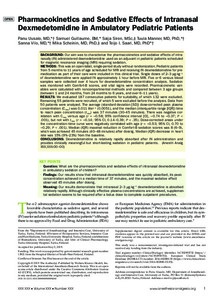Pharmacokinetics and Sedative Effects of Intranasal Dexmedetomidine in Ambulatory Pediatric Patients
Uusalo Panu; Guillaume Samuel; Siren Saija; Manner Tuula; Vilo Sanna; Scheinin Mika; Saari Teijo I.
https://urn.fi/URN:NBN:fi-fe2021042821333
Tiivistelmä
BACKGROUND:
Our aim was to characterize the pharmacokinetics and sedative effects of intranasally (IN) administered dexmedetomidine used as an adjuvant in pediatric patients scheduled for magnetic resonance imaging (MRI) requiring sedation.
METHODS:
This was an open-label, single-period study without randomization. Pediatric patients from 5 months to 11 years of age scheduled for MRI and receiving IN dexmedetomidine for premedication as part of their care were included in this clinical trial. Single doses of 2-3 µg·kg of dexmedetomidine were applied IN approximately 1 hour before MRI. Five or 6 venous blood samples were collected over 4 hours for dexmedetomidine concentration analysis. Sedation was monitored with Comfort-B scores, and vital signs were recorded. Pharmacokinetic variables were calculated with noncompartmental methods and compared between 3 age groups (between 1 and 24 months, from 24 months to 6 years, and over 6-11 years).
RESULTS:
We evaluated 187 consecutive patients for suitability, of which 132 were excluded. Remaining 55 patients were recruited, of which 5 were excluded before the analysis. Data from 50 patients were analyzed. The average (standard deviation [SD]) dose-corrected peak plasma concentration (Cmax) was 0.011 liter (0.0051), and the median (interquartile range [IQR]) time to reach peak concentration (tmax) was 37 minutes (30-45 minutes). There was negative correlation with Cmax versus age (r = -0.58; 95% confidence interval [CI], -0.74 to -0.37; P < .001), but not with tmax (r = -0.14; 95% CI, 0.14-0.39; P = .35). Dose-corrected areas under the concentration-time curve were negatively correlated with age (r = -0.53; 95% CI, 0.70 to -0.29; P < .001). Median (IQR) maximal reduction in Comfort-B sedation scores was 8 (6-9), which was achieved 45 minutes (40-48 minutes) after dosing. Median (IQR) decrease in heart rate was 15% (9%-23%) from the baseline.
CONCLUSIONS:
Dexmedetomidine is relatively rapidly absorbed after IN administration and provides clinically meaningful but short-lasting sedation in pediatric patients.
Kokoelmat
- Rinnakkaistallenteet [27094]
